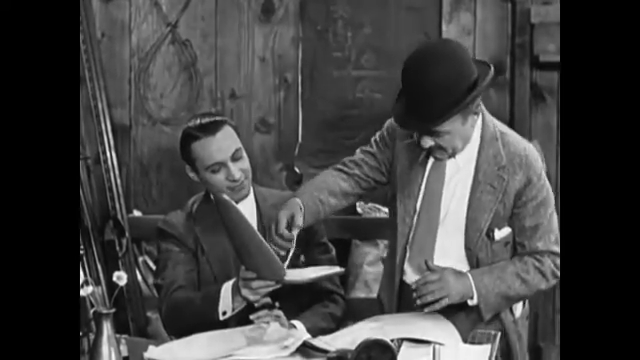Thou shalt remake me in Technicolor
When most people hear “Cecil B. DeMille’s The Ten Commandments,” their mind goes to the 1956 epic — the one with a four-hour runtime and Charlton Heston’s gradually-expanding beard. What many do not know is that DeMille was remaking his own film: three decades earlier, he produced and directed a movie also called The Ten Commandments, a silent film from 1923.
Except… it’s actually a little more complicated than that. The 1956 film is not really remake of the 1923 film. This is because the majority of the original film is actually contemporary, set in the 20th century. It’s only a prologue that makes up a little less than half the runtime that tells the Exodus story. After Moses frees the Hebrews and receives the commandments from God (via skywriting), the movie abruptly pivots to a modern morality tale. The rest of the runtime is a 1920s parable about two brothers and the dangers of cheaping out on your concrete supply.
To be clear, the Moses section is terrific for the duration we have it. The slight uncanniness and detachment of silent cinema is a perfect match for the mythic quality of Old Testament stories. There’s a heft to the gestures and biblical acts, a heightened reality suited well by theatrical ‘20s acting and intertitles quoting The Good Book. Theodore Roberts’ Moses is gaunt and imposing, stepping out of shadows of the Pharaoh’s palace like a creeping spectre. The production is astonishing for the time, though it pales compared to DeMille’s landmark 1956 epic. But I actually like some of the set design here more than the ‘50s film: the palace is shadowy, almost evoking the “liminal space” aesthetic that’s hot these days. The outdoor shots are remarkable too: huge, sandy vistas with giant statues and gates. (Curiously, DeMille and the crew never removed the sets, which eventually sank under the sandy surface of the California dunes where DeMille shot the film. Archaeologists began digging and recovering the sets in 2012, nearly a century after filming.)

The most famous moment of the Moses story, the big payoff in every adaptation, is the sequence of the Moses parting the Red Sea (then un-parting it on top of Egyptian soldiers), and it does not disappoint here. Special effects technology was still primitive in 1923, but the segment remains pretty dazzling. Using practical effects (including some Jell-O) and trick photography (the rising waves clearly a collapse played in reverse), DeMille pushed the limits of early 1920s spectacle. It pales compared to the sensational effect of the same moment in the 1956 film, but the sense of grandeur is there, and it endures.
It is ridiculously jarring a few minutes later when the film smash cuts to modern-day San Francisco, and suddenly The Ten Commandments becomes is a contemporary moral parable for the majority of its duration. The lesson of this morality play is that we must follow The Bible’s teachings in this crazy, modern world, lest we… uh, form a construction company and catch leprosy. This second half, subtitled “The Story” (the Exodus section being “The Prologue”) follows two brothers: one a pious carpenter (subtle) named John (Richard Dix) and one a mustache-twirling atheist named Dan (Rod La Rocque) who literally vows to his devout mother (Edythe Chapman) that he will live his life breaking every single one of the titular commandments.
To DeMille’s credit, this stretch is handsomely staged and well acted. But as an actual story, it is unintentionally hilarious. The earnestness with which the film depicts atheism as a gateway to brothels and capitalistic greed is D.W. Griffith levels of moral absolutism. Speaking of Griffith, I think this concept of historically paralleled stories derives from Intolerance, the O.G. silent epic that pulled the same trick of tying historical events to modern moral foibles. Intolerance is, suffice to say, much more cinematic and thoughtful than this, stodgy though that film is. There’s also some Phantom Carriage in here of man’s torn moral fiber causing his downfall, but none of the moody ghostliness and gray edges of that preachy fable.

The film’s two halves simply don’t fit together. DeMille and screenwriter Jeanie MacPherson glue the narratives with the throughline of the Ten Commandments, even evoking them with similar glowing writing in both halves, but it really does not hold. The halves are not mirrored or bound together in any insightful way. The shift in tone and setting is too extreme, the payoff too little, so it’s like we’re watching two consecutive short films.
Still, as a curio, this Ten Commandments is fascinating. The Moses half of the film remains a rock solid bit of early epic cinema, hampered only by its short length. It’s not too hard to see why DeMille, three decades later and fresh off a Best Picture win with The Greatest Show on Earth, would want to revisit the story as a glory years project sans modern segment. That’s The Ten Commndments 1923’s biggest legacy: paving the groundwork for the widescreen, color-saturated remake that remains one of the highest-grossing films of all time (adjusted for inflation). The 1923 Ten Commandments is not a great film, but it’s a nifty piece of film history.
Is It Good?
Nearly Good (4/8)
Dan is the founder and head critic of The Goods. Follow Dan on Letterboxd. Join the Discord for updates and discussion.


2 replies on “The Ten Commandments (1923)”
I land about it in the same place, though my recollection is that even the “prologue” stuff winds up suffering, maybe going a little too summary, because it’s not the focus of the entire production’s attention.
The main narrative is, as you say, so goofy. The ending is not good, but certainly very memorable.
(I nevertheless strongly prefer it to The Phantom Carriage.)
Good point on the Moses stuff being so abbreviated it loses a little bit of its punch. I felt that too, but realized I hadn’t actually called that out so I added it to my review.
Yeah, your panning of The Phantom Carriage definitely caught my eye when you wrote about it a couple years ago. Maybe I was caught in “I’m watching serious cinema” mode and gave it more benefit of the bore than it deserved.